Uptake of Climate-Smart Agricultural Technologies and Practices: Actual and Potential Adoption Rates in the Climate-Smart Village Site of Mali
Abstract
:1. Introduction
2. Materials and Methods
2.1. Study Area and Data
2.2. Theoretical Framework for Adoption Assessment
2.3. Empirical Model
3. Results
3.1. Socio-economic Characteristics of Households
3.2. Awareness and Utilization of CSA Technologies and Practices in the CSV Site of Cinzana
3.3. Perceveid Reasons and Constraints to Adopting CSA Technologies and Practices
3.4. Determinants of Awareness of CSA Practices
3.5. Actual and Potential Adoption of CSA Technologies and Practices
3.6. Determinants of Adoption of CSA Practices
4. Discussion
4.1. Awareness and Adoption of CSA Practices and Technologies: Adoption Gap
4.2. Drivers of Awareness and Adoption of CSA Practices and Technologies
5. Conclusions
Author Contributions
Funding
Acknowledgments
Conflicts of Interest
References
- FAO. The State of Food and Agriculture. Food and Agriculture Organization of the United Nations, 2016. Available online: http://www.fao.org/3/a-i6030e.pdf (accessed on 10 April 2019).
- Altieri, M.A.; Nicholls, C.I. The adaptation and mitigation potential of traditional agriculture in a changing climate. Clim. Chang. 2017, 140, 33–45. [Google Scholar] [CrossRef]
- Jalloh, A.; Nelson, G.C.; Thomas, T.S.; Zougmoré, R.B.; Roy-Macauley, H. (Eds.) West African Agriculture and Climate Change: A Comprehensive Analysis; International Food Policy Research Institute: Washington, DC, USA, 2013. [Google Scholar]
- FAO. Climate-Smart Agriculture Sourcebook 2013; Food and Agriculture Organization of the United Nations: Rome, Italy, 2013. [Google Scholar]
- Aggarwal, P.K.; Jarvis, A.; Campbell, M.B.; Zougmoré, B.R.; Khatri-Chhetri, A.; Vermeulen, J.S.; Loboguerrero, A.; Sebastian, S.L.; Kinyangi, J.; Bonilla-Findji, O.; et al. The climate-smart village approach: Framework of an integrative strategy for scaling up adaptation options in agriculture. Ecol. Soc. 2018, 23, 14. [Google Scholar] [CrossRef]
- Sileshi, G.W.; Akinnifesi, F.K.; Ajayi, O.C.; Muys, B. Integration of legume trees in maize-based cropping systems improves rain use efficiency and yield stability under rain-fed agriculture. Agric. Water Manag. 2011, 98, 1364–1372. [Google Scholar] [CrossRef]
- Traore, K.; Sidibe, D.K.; Coulibaly, H.; Bayala, J. Optimizing yield of improved varieties of millet and sorghum under highly variable rainfall conditions using contour ridges in Cinzana, Mali. Agric. Food Secur. 2017, 6, 11. [Google Scholar] [CrossRef]
- Bayala, J.; Zougmoré, R.; Ky-Dembele, C.; Bationo, B.A.; Buah, S.; Sanogo, D.; Somda, J.; Tougiani, A.; Traoré, K.; Kalinganire, A. Towards developing scalable climate-smart village models: Approach and lessons learnt from pilot research in West Africa. In ICRAF Occasional Paper No. 25; World Agroforestry Centre: Nairobi, Kenya, 2016. [Google Scholar]
- Sanou, J.; Bationo, A.B.; Barry, S.; Nabie, D.L.; Bayala, J.; Zougmore, R. Combining soil fertilization, cropping systems and improved varieties to minimize climate risks on farming productivity in northern region of Burkina Faso. Agric. Food Secur. 2016, 5, 20. [Google Scholar] [CrossRef] [Green Version]
- Andrieu, N.; Sogoba, B.; Zougmore, R.; Howland, F.; Samake, O.; Bonilla-Findji, O.; Lizarazo, M.; Nowak, A.; Dembele, C.; Corner-Dolloff, C. Prioritizing investments for climate-smart agriculture: Lessons learned from Mali. Agric. Syst. 2017, 154, 13–24. [Google Scholar] [CrossRef] [Green Version]
- Tiamiyu, A.S.; Ugalahi, B.U.; Eze, N.J.; Shittu, A.M. Adoption of climate smart agricultural practices and farmers’ willingness to accept incentives in Nigeria. IJAER 2018, 4, 198–205. [Google Scholar]
- Maguza-Tembo, F.; Abdi-Khalil, E.; Mangisoni, J.; Mkwambisi, D. Does Adoption of Climate Smart Agriculture (CSA) Technologies Reduce Household Vulnerability to Poverty? J. Econ. Sustain. Dev. 2016, 7, 125–130. [Google Scholar]
- Diagne, A. Technological change in smallholder agriculture: Bridging the adoption gap by understanding its source. AfJARE 2010, 5, 261–286. [Google Scholar]
- Angrist, J.D.; Imbens, G.W. Two-stage least squares estimation of average causal effects in models with variable treatment intensity. J. Am. Stat. Assoc. 1995, 90, 431–442. [Google Scholar] [CrossRef]
- Heckman, J.J.; Vytlacil, E. Structural equations, treatment effects, and econometric policy evaluation 1. Econometrica 2005, 73, 669–738. [Google Scholar] [CrossRef]
- Imbens, G.W.; Wooldridge, J.M. Recent developments in the econometrics of program evaluation. J. Econ. Lit. 2009, 47, 5–86. [Google Scholar] [CrossRef]
- Ouédraogo, M.; Dakouo, D. Evaluation de l'adoption des variétés de riz NERICA dans l’Ouest du Burkina Faso. Afr. J. Agric. Resour. Econ.-AfJARE 2017, 12, 1–16. [Google Scholar]
- Ouédraogo, M.; Zougmoré, R.; Moussa, A.S.; Partey, S.T.; Thornton, P.K.; Kristjanson, P.; Diakité, L. Markets and climate are driving rapid change in farming practices in Savannah West Africa. Reg. Environ. Chang. 2017, 17, 437–449. [Google Scholar] [CrossRef]
- CCAFS. 2011. Available online: https://ccafs.cgiar.org/ (accessed on 01 July 2019).
- Diagne, A.; Demont, M. Taking a new look at empirical models of adoption: Average treatment effect estimation of adoption rates and their determinants. Agric. Econ. 2007, 37, 201–210. [Google Scholar] [CrossRef]
- Dandedjrohoun, L.; Diagne, A.; Biaou, G.; N’cho, S.; Midingoyi, K.S. Determinants of diffusion and adoption of improved technology for rice parboiling in Benin. Rev. Agric. Environ. Stud. 2012, 93, 171–191. [Google Scholar]
- Heckman, J. Randomization and social program evaluation as an instrumental variable. Rev. Econ. Stat. 1996, 77, 336–341. [Google Scholar] [CrossRef]
- Diagne, A. The diffusion and adoption of NERICA rice varieties in Côte d’Ivoire. Dev. Econ. 2006, 44, 208–231. [Google Scholar] [CrossRef]
- Wooldridge, J. Econometric Analysis of Cross Section and Panel Data; The MIT Press: Cambridge, MA, USA, 2002. [Google Scholar]
- Mensah, E.J. Land tenure regimes and land conservation in the African drylands: The case of northern Ghana. J. Land Use Sci. 2015, 10, 129–149. [Google Scholar] [CrossRef]
- Abdulai, A.; Huffman, W. The adoption and impact of soil and water conservation technology: An endogenous switching regression application. Land Econ. 2014, 90, 26–43. [Google Scholar] [CrossRef]
- Makate, C.; Wang, R.; Makate, M.; Mango, N. Crop diversification and livelihoods of smallholder farmers in Zimbabwe: Adaptive management for environmental change. SpringerPlus 2016, 5, 1135. [Google Scholar] [CrossRef] [PubMed]
- Fouladbash, L.; Currie, W.S. Agroforestry in Liberia: Household practices, perceptions and livelihood benefits. Agrofor. Syst. 2015, 89, 247–266. [Google Scholar] [CrossRef]
- Nigussie, Z.; Tsunekawa, A.; Haregeweyn, N.; Adgo, E.; Nohmi, M.; Tsubo, M.; Abele, S. Factors influencing small-scale farmers’ adoption of sustainable land management technologies in north-western Ethiopia. Land Use Policy 2017, 67, 57–64. [Google Scholar] [CrossRef]
- Rogers, E.M. Diffusion of Innovations, 5th ed.; Free Press: New York, NY, USA, 2003. [Google Scholar]
- Giller, K.E.; Witter, E.; Corbeels, M.; Tittonell, P. Conservation agriculture and smallholder farming in Africa: The heretics’ view. Field Crops Res. 2009, 114, 23–34. [Google Scholar] [CrossRef]
- Kpadonou, R.A.B.; Owiyo, T.; Barbier, B.; Denton, F.; Rutabingwa, F.; Kiema, A. Advancing climate-smart-agriculture in developing drylands: Joint analysis of the adoption of multiple on-farm soil and water conservation technologies in West African Sahel. Land Use Policy 2017, 61, 196–207. [Google Scholar] [CrossRef]
- Ward, P.S.; Bell, A.R.; Droppelmann, K.; Benton, T.G. Early adoption of conservation agriculture practices: Understanding partial compliance in programs with multiple adoption decisions. Land Use Policy 2018, 70, 27–37. [Google Scholar] [CrossRef]
- Quinion, A.; Chirwa, P.W.; Akinnifesi, F.K.; Ajayi, O.C. Do agroforestry technologies improve the livelihoods of the resource poor farmers? Evidence from Kasungu and Machinga districts of Malawi. Agrofor. Syst. 2010, 80, 457–465. [Google Scholar] [CrossRef]
- Fallah, S.; Rostaei, M.; Lorigooini, Z.; Surki, A.A. Chemical compositions of essential oil and antioxidant activity of dragonhead (Dracocephalum moldavica) in sole crop and dragonhead-soybean (Glycine max) intercropping system under organic manure and chemical fertilizers. Ind. Crops Prod. 2018, 115, 158–165. [Google Scholar] [CrossRef]
- Nelson, W.C.D.; Hoffmann, M.P.; Vadez, V.; Roetter, R.P.; Whitbread, A.M. Testing pearl millet and cowpea intercropping systems under high temperatures. Field Crops Res. 2018, 217, 150–166. [Google Scholar] [CrossRef] [Green Version]
- Schröder, D.; Köpke, U. Faba bean (Vicia faba L.) intercropped with oil crops—A strategy to enhance rooting density and to optimize nitrogen use and grain production? Field Crops Res. 2012, 135, 74–81. [Google Scholar]
- Corre-Hellou, G.; Dibet, A.; Hauggaard-Nielsen, H.; Crozat, Y.; Gooding, M.; Ambus, P.; Ensen, E.S. The competitive ability of pea—Barley intercrops against weeds and the interactions with crop productivity and soil N availability. Field Crops Res. 2011, 122, 264–272. [Google Scholar] [CrossRef]
- Murendo, C.; Wollni, M. Ex-post Impact Assessment of Fertilizer Microdosing as a Climate-Smart Technology in Sub-Saharan Africa; CCAFS: Frederiksberg, Denmark, 2015. [Google Scholar]
- Khatri-Chhetri, A.; Aggarwal, P.K.; Joshi, P.K.; Vyas, S. Farmers’ prioritization of climate-smart agriculture (CSA) technologies. Agric. Syst. 2017, 151, 184–191. [Google Scholar] [CrossRef]
- Palanisami, K.; Kumar, D.S.; Malik, R.P.S.; Raman, S.; Kar, G.; Monhan, K. Managing water management research: Analysis of four decades of research and outreach programmes in India. Econ. Political Rev. 2015, 26–27, 33–43. [Google Scholar]
- Mwongera, C.; Shikuku, K.M.; Twyman, J.; Läderach, P.; Ampaire, E.; Van Asten, P.; Winowiecki, L.A. Climate smart agriculture rapid appraisal (CSA-RA): A tool for prioritizing context-specific climate smart agriculture technologies. Agric. Syst. 2017, 151, 192–203. [Google Scholar] [CrossRef]
- Hall, B.; Khan, B. Adoption of New Technology. In New Economy Handboo; Jones, D.C., Ed.; Elsevier Science: Amsterdam, The Netherlands, 2003. [Google Scholar]
- Campbell, J.; Cheong, S.; McCormick, M.; Pulwarty, S.; Supratid, R.S.; Ziervogel, G. Managing the risks from climate extremes at the local level. Managing the Risks of Extreme Events and Disasters to Advance Climate Change Adaptation. In A Special Report of Working Groups I and II of the IPCC; Cambridge University Press: Cambridge, UK; New York, NY, USA, 2012. [Google Scholar]
- Below, T.B.; Mutabazi, K.D.; Kirschke, D.; Franke, C.; Sieber, S.; Siebert, R.; Tscherning, K. Can farmers’ adaptation to climate change be explained by socio-economic household-level variables? Glob. Environ. Chang. 2012, 22, 223–235. [Google Scholar] [CrossRef]
- Deressa, T.T.; Hassan, R.M.; Ringler, C. Perception of and adaptation to climate change by farmers in the Nile basin of Ethiopia. J. Agric. Sci. 2011, 149, 23–31. [Google Scholar] [CrossRef]
- Nkomoki, W.; Bavorová, M.; Banout, J. Adoption of sustainable agricultural practices and food security threats: Effects of land tenure in Zambia. Land Use Policy 2018, 78, 532–538. [Google Scholar] [CrossRef]
- Faße, A.; Grote, U. The economic relevance of sustainable agroforestry practices—An empirical analysis from Tanzania. Ecol. Econ. 2013, 94, 86–96. [Google Scholar] [CrossRef]
- Kassie, M.; Teklewold, H.; Jaleta, M.; Marenya, P.; Erenstein, O. Understanding the adoption of a portfolio of sustainable intensification practices in eastern and southern Africa. Land Use Policy 2015, 42, 400–411. [Google Scholar] [CrossRef]
- Kagoya, S.; Paudel, K.P.; Daniel, N.L. Awareness and Adoption of Soil and Water Conservation Technologies in a Developing Country: A Case of Nabajuzi Watershed in Central Uganda. Environ. Manag. 2018, 61, 188–196. [Google Scholar] [CrossRef]
- Amsalu, A.; De Graaff, J. Determinants of adoption and continued use of stone terraces for soil and water conservation in an Ethiopian highland watershed. Ecol. Econ. 2007, 61, 294–302. [Google Scholar] [CrossRef]
- Bayard, B.; Jolly, C.M.; Shannon, D.A. The economics of adoption and management of alley cropping in Haiti. J. Environ. Manag. 2007, 84, 62–70. [Google Scholar] [CrossRef] [PubMed]
- Holden, S.T.; Fisher, M.; Katengeza, S.P.; Thierfelder, C. Can lead farmers reveal the adoption potential of conservation agriculture? The case of Malawi. Land Use Policy 2018, 76, 113–123. [Google Scholar] [CrossRef]
- Gauchan, D.; Shrestha, S. Agricultural and Rural Mechanisation in Nepal: Status, Issues and Options for Future; Institute for Inclusive Finance and Development (InM): Dhaka, Bangladesh, 2017. [Google Scholar]
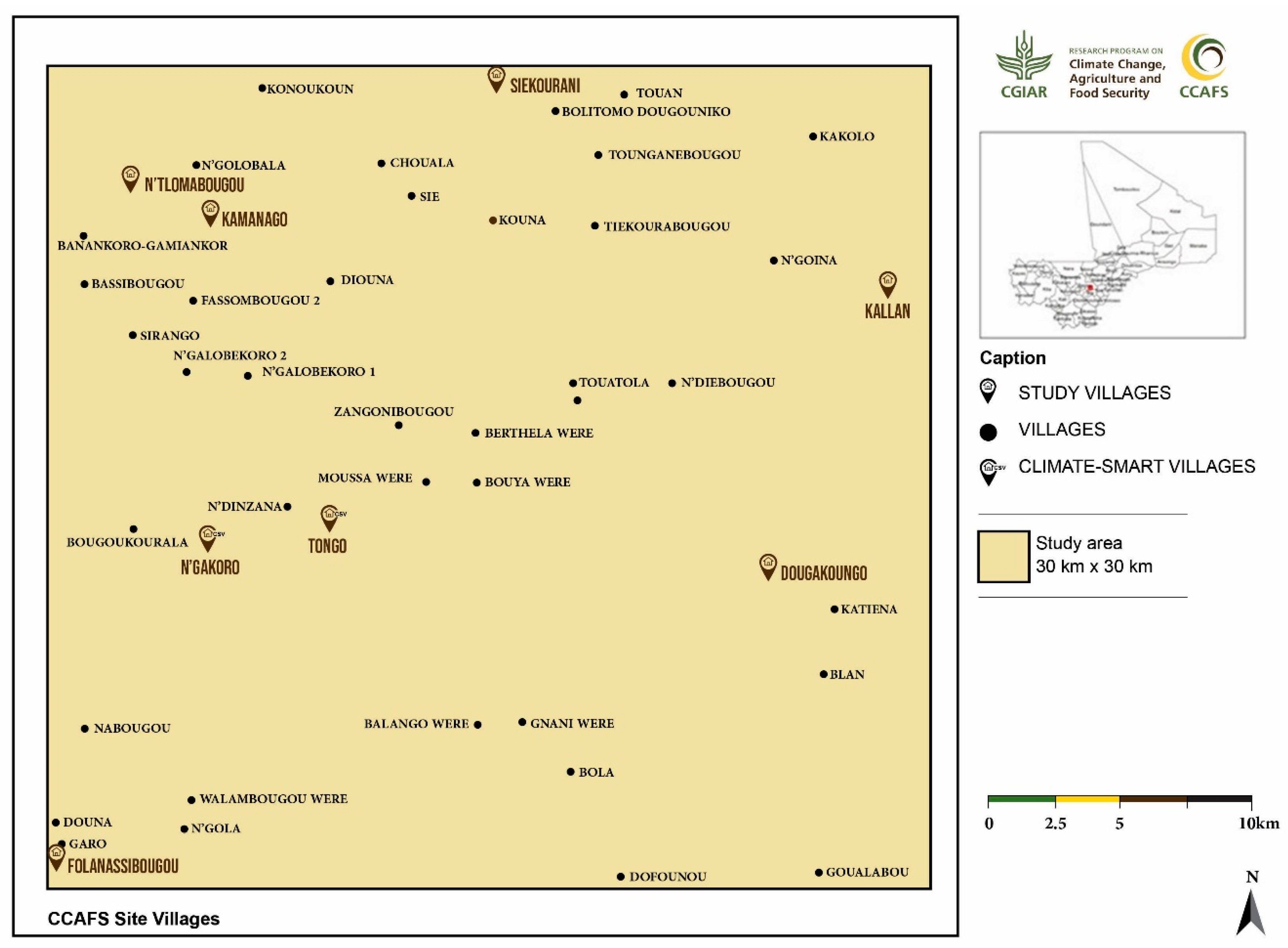


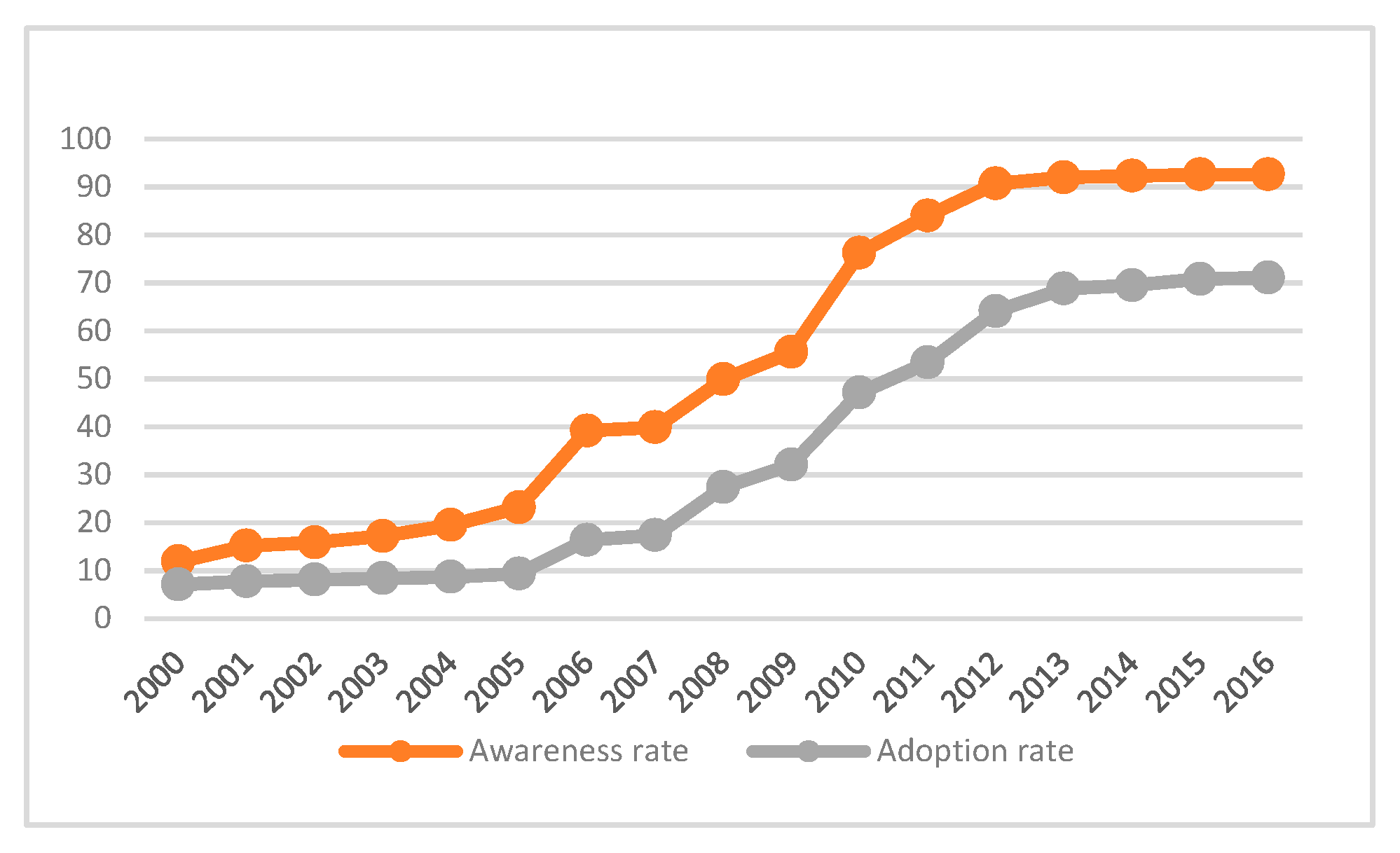
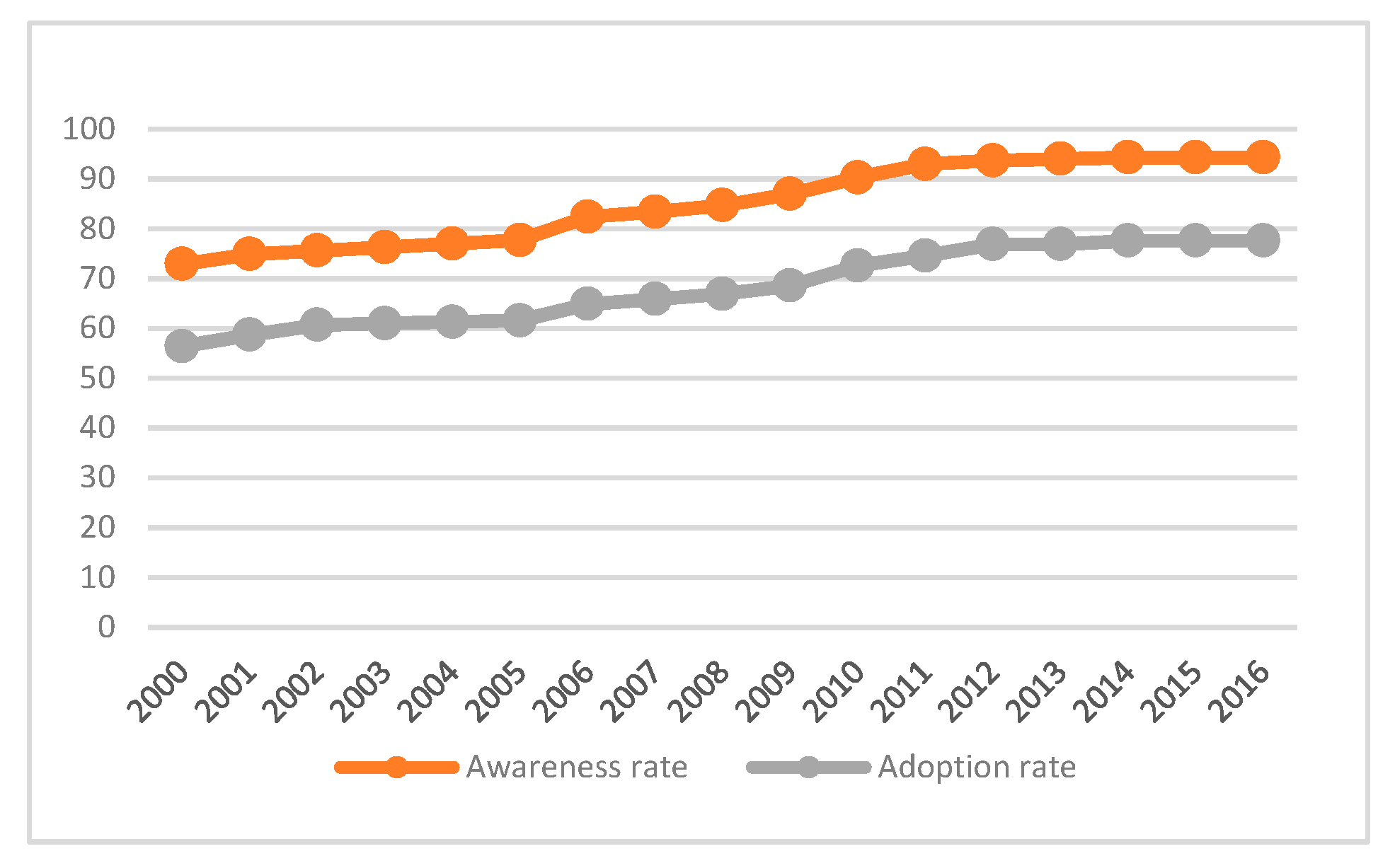
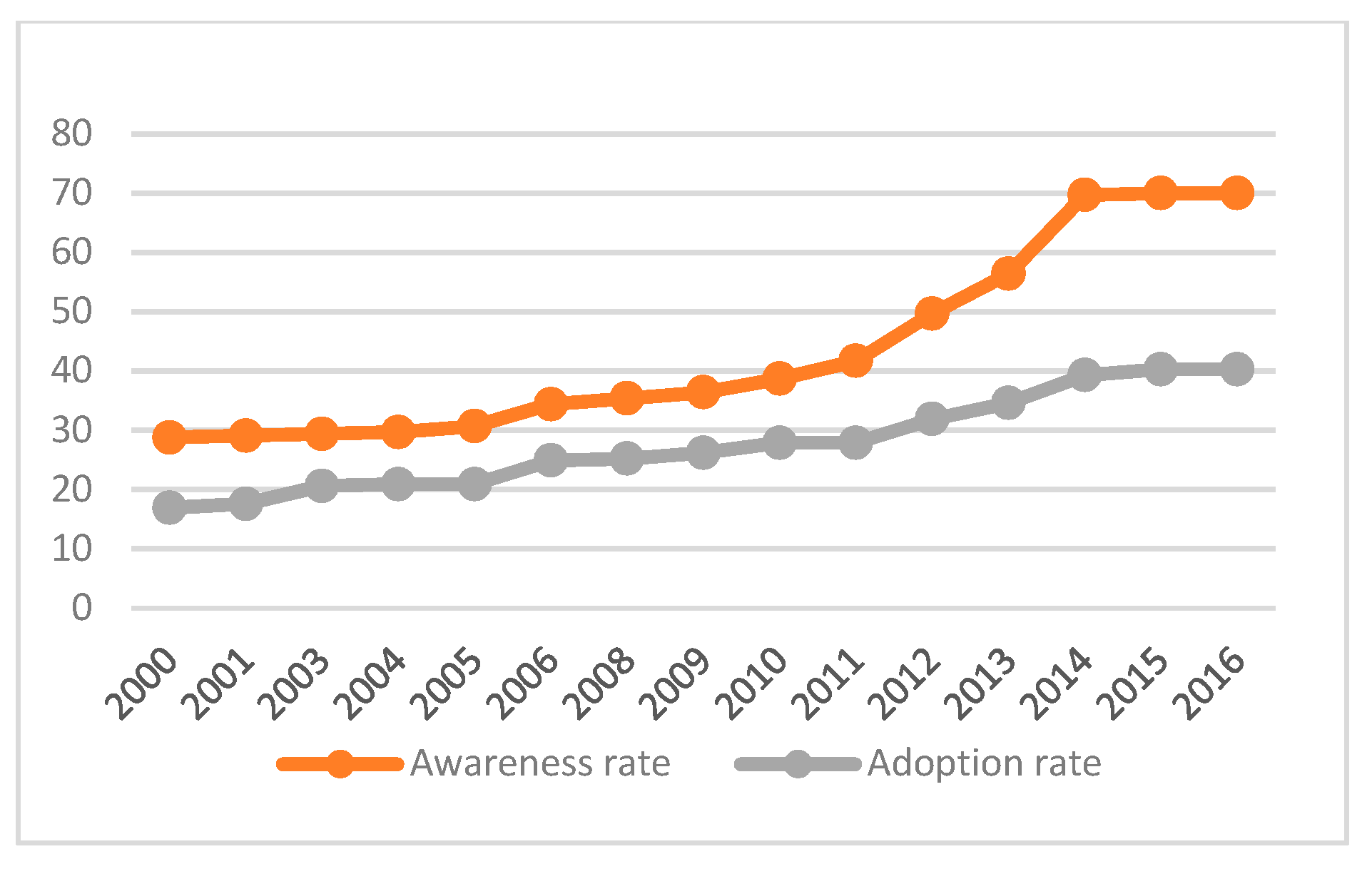
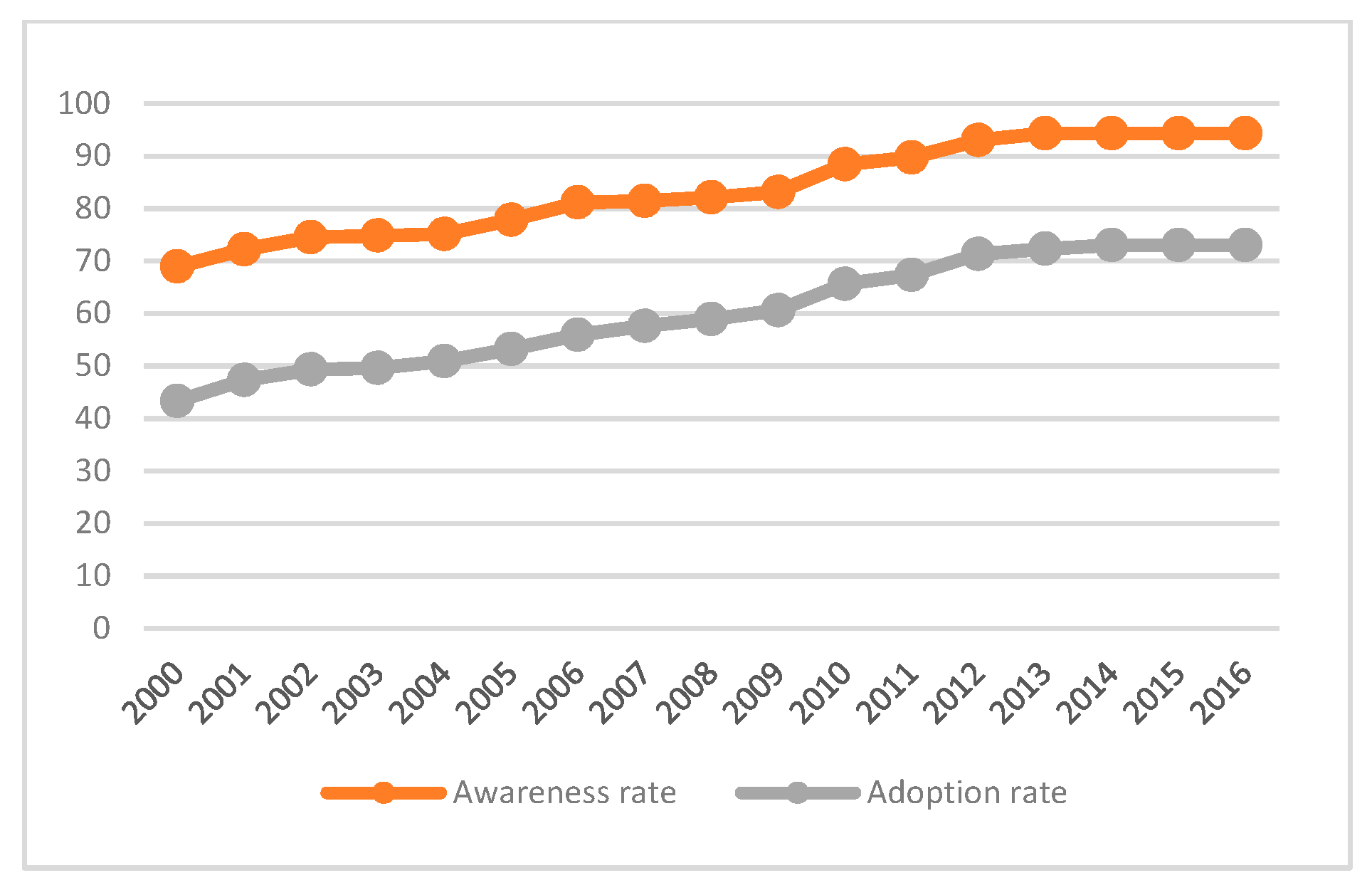
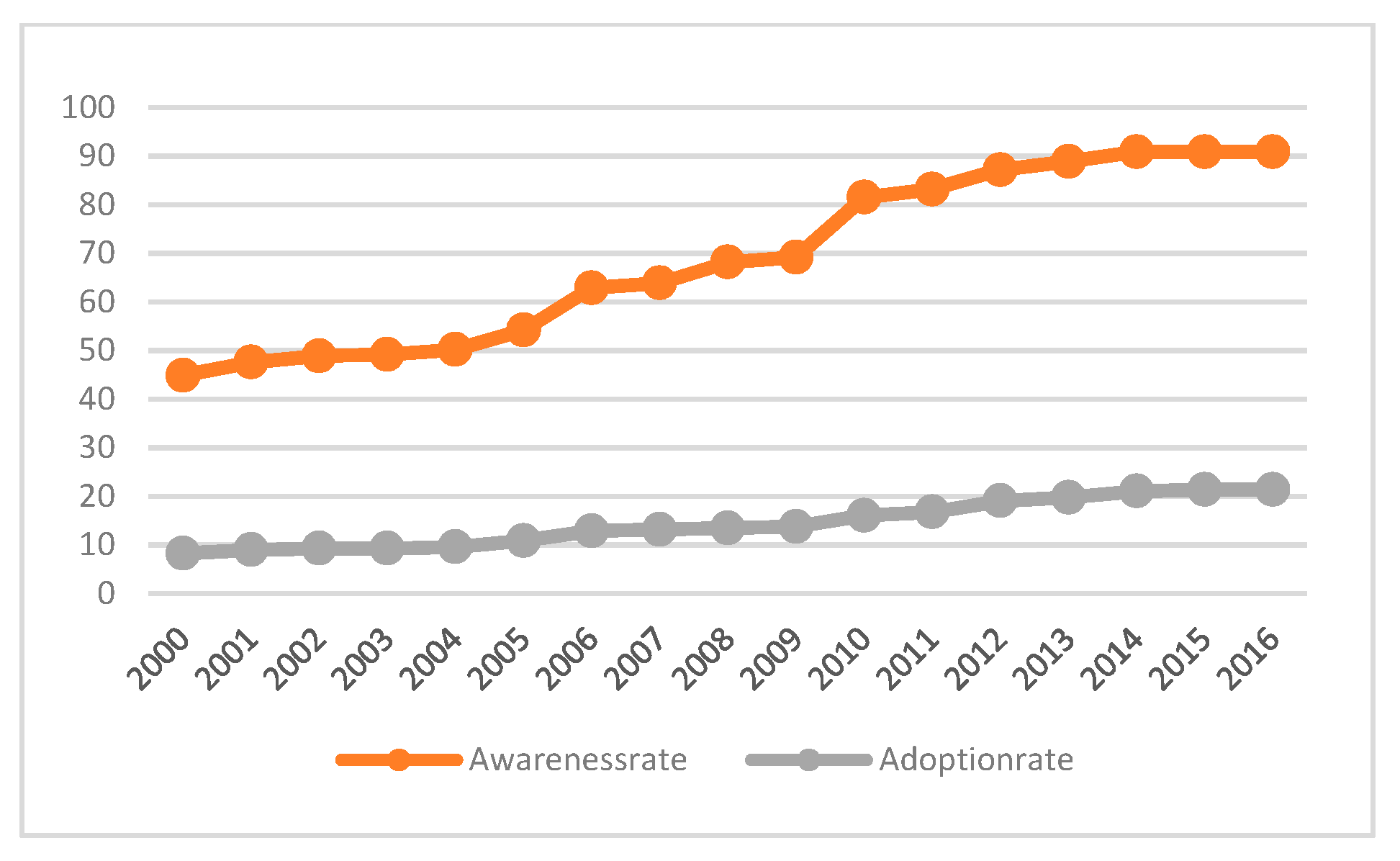
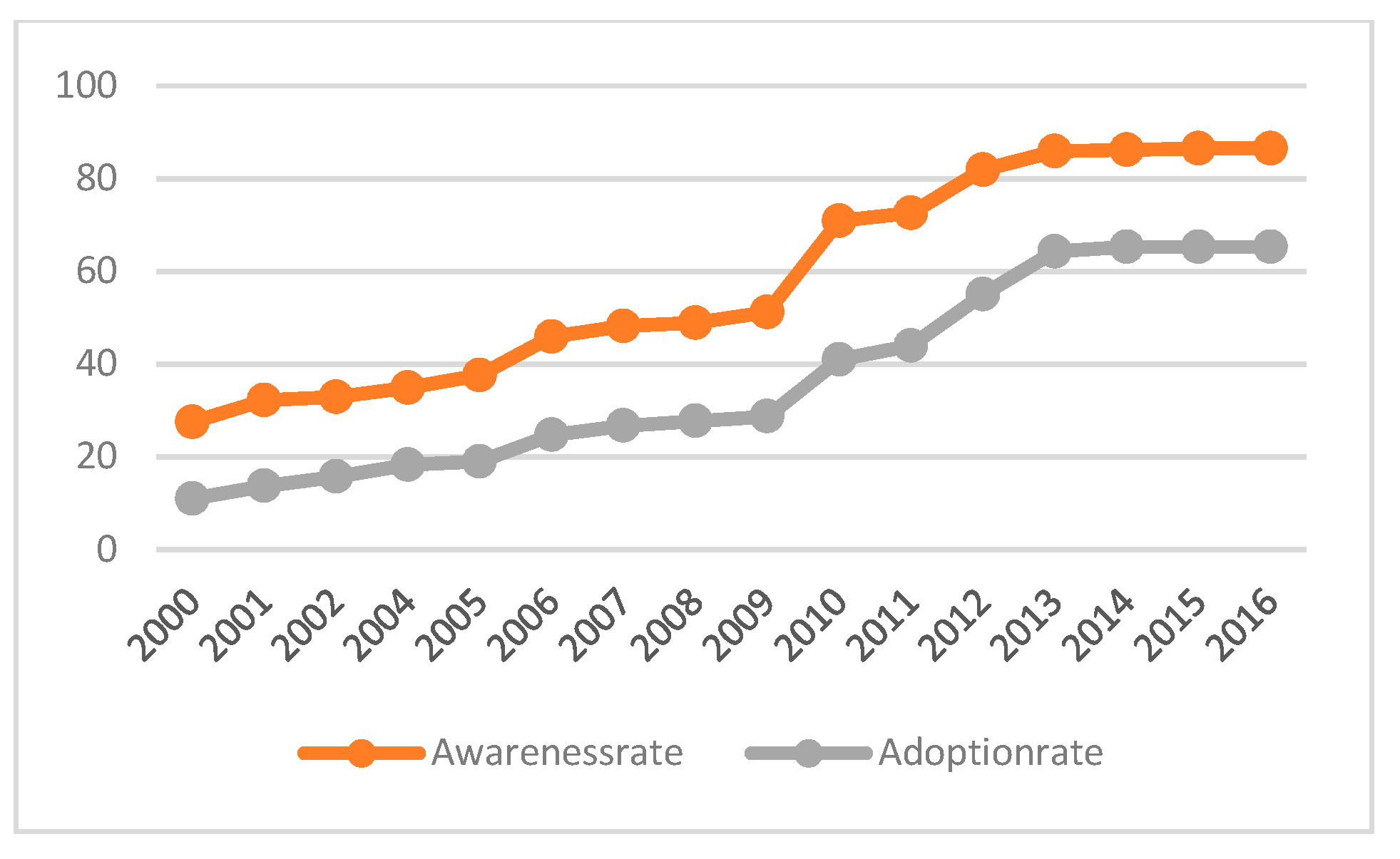
| Variables | Description | Expected Sign |
|---|---|---|
| Education | Dummy = 1 if household head attended formal schooling | + |
| Extension service | Dummy = 1 if household has contact with public extension services | + |
| Experience in farming | Number of years in farming | + |
| Training on agricultural system | Dummy = 1 if household head attended any training in agricultural production | + |
| Owning a radio | Dummy = 1 if a household member owns a radio | + |
| Number of workers in household | Number of persons in the household able to work in farm | +/- |
| Access to credit | Dummy = 1 if the household has access to credit | + |
| Access to subsidy | Dummy = 1 if the household has access to subsidies | + |
| Total land size | Total size of landholding in hectares | + |
| Animal traction | Dummy = 1 if the household head holds a couple of traction cattle with a plough or cart | + |
| Training on choice of varieties | Dummy = 1 if the household head attended a specific training in choice of varieties | + |
| Training on Climate information service | Dummy = 1 if the household head attended a specific training in Use of Climate information | + |
| Off-farm activities | Dummy = 1 if the household has off-farm activities | + |
| Owning a phone | Dummy = 1 if a household member owns a mobile phone | + |
| Variables | Mean | Std. Dev. | Min | Max |
|---|---|---|---|---|
| Household (HH) characteristics | ||||
| Age of the HH head (year) | 51.61 | 13.34 | 18 | 87 |
| Gender male of HH head | 0.98 | 0.14 | 0 | 1 |
| Education of HH | 0.07 | 0.26 | 0 | 1 |
| Number of persons in the HH | 17.19 | 14.56 | 1 | 105 |
| Number of workers in HH | 6.85 | 6.40 | 1 | 40 |
| Household’s status (migrant) | 0.11 | 0.32 | 0 | 1 |
| Member of Farmers’ Organization | 0.72 | 0.44 | 0 | 1 |
| Number of years in farming (experience) | 25.69 | 14.76 | 3 | 60 |
| Access to credit | 0.20 | 0.40 | 0 | 1 |
| Access to subsidies | 0.3 | 0.45 | 0 | 1 |
| Off-farm activities | 0.36 | 0.48 | 0 | 1 |
| Farm characteristics | ||||
| Farm seize (ha) | 10.78 | 9.75 | 1 | 100 |
| Land size under cultivation (ha) | 9.45 | 7.21 | 1 | 40 |
| Subsistence farm | 0.14 | 0.35 | 0 | 1 |
| Number of cash crops | 2.08 | 1.06 | 0 | 5 |
| Livestock animals holding | 0.97 | 0.16 | 0 | 1 |
| Oxen holding | 4.33 | 7.55 | 0 | 50 |
| Traction cattle | 2.96 | 2.78 | 0 | 30 |
| Small ruminant holding | 13.26 | 15.10 | 0 | 120 |
| Poultry | 16.40 | 23.92 | 0 | 210 |
| Plough | 1.34 | 1.15 | 0 | 7 |
| Cart | 1.38 | 1.40 | 0 | 20 |
| Animal traction | 0.68 | 0.46 | 0 | 1 |
| Institution and technical knowledge | ||||
| Extension service | 0.42 | 0.49 | 0 | 1 |
| Training on agricultural system | 0.75 | 0.43 | 0 | 1 |
| Choice of varieties | 0.56 | 0.49 | 0 | 1 |
| Soil fertility management | 0.15 | 0.36 | 0 | 1 |
| Climate information service | 0.42 | 0.49 | 0 | 1 |
| Radio set | 0.76 | 0.42 | 0 | 1 |
| Mobile phone | 0.90 | 0.30 | 0 | 1 |
| Drought Tolerant Variety | Organic Manure | Micro-Dosing | Intercropping | Contour Farming | Agroforestry | FMNR | CIS | |
|---|---|---|---|---|---|---|---|---|
| Improve productivity | 57.01 | 41.62 | 45.01 | 37.60 | 16.58 | 3.70 | 5.77 | 16.86 |
| Improve soil fertility/moisture | 3.35 | 39.80 | 18.52 | 17.71 | 54.55 | 7.41 | 2.36 | 1.18 |
| Reduces the risk of crop losses | 16.46 | 10.91 | 5.98 | 1.36 | 19.25 | 2.22 | 0.26 | 1.18 |
| Increase income | 22.26 | 6.26 | 5.13 | 37.87 | 2.14 | 7.41 | 1.57 | 0.39 |
| Low inputs/labor cost | 0.91 | 1.41 | 25.36 | 2.72 | 7.49 | 0.74 | 0.00 | 0.39 |
| Access to forest product/fodder | 0.00 | 0.00 | 0.00 | 2.72 | 0.00 | 78.52 | 90.03 | 0.00 |
| Drought Tolerant Variety | Organic Manure | Micro-Dosing | Inter Cropping | Contour Farming | Agroforestry | FMNR | CIS | |
|---|---|---|---|---|---|---|---|---|
| Illiteracy of farmers | 16.00 | 9.34 | 10.77 | 10.47 | 19.39 | 9.98 | 8.87 | 33.24 |
| Limited technical capacity | 26.60 | 40.66 | 24.12 | 24.61 | 26.06 | 15.91 | 9.83 | 15.29 |
| Lack of information about the technology/practice | 16.20 | 25.68 | 25.76 | 9.16 | 29.09 | 21.14 | 17.27 | 38.24 |
| Unappropriated technology/practice | 36.00 | 20.62 | 31.38 | 35.08 | 16.36 | 19.24 | 39.09 | 8.82 |
| Limited funds | 5.00 | 1.75 | 6.79 | 3.93 | 4.24 | 9.50 | 1.92 | 3.53 |
| Land insufficiency | 0.00 | 0.00 | 0.00 | 0.00 | 0.30 | 12.35 | 5.04 | 0.00 |
| Lack of water | 0.00 | 0.58 | 0.23 | 0.26 | 0.00 | 11.16 | 12.23 | 0.00 |
| No specific constraint | 0.20 | 1.36 | 0.94 | 16.49 | 4.55 | 0.71 | 5.76 | 0.88 |
| Drought Tolerant Variety | Micro-Dosing | intercropping | Contour Ridging | FMNR | CIS | |
|---|---|---|---|---|---|---|
| Education (1 = yes, 0 = otherwise) | 0.04 * (0.03) | 0.03 (0.03) | 0.08 ** (0.033) | −0.02 (0.06) | 0.05 * (0.03) | 0.01 (0.04) |
| Extension service (1 = yes, 0 = otherwise) | 0.06 *** (0.02) | 0.08 *** (0.03) | 0.004 (0.01) | 0.01 (0.06) | 0.002 (0.02) | −0.003 (0.04) |
| Year of experience in farming | −0.0003 (0.0005) | 0.0003 (0.0009) | −0.003 (0.0003) | 0.001 (0.002) | −0.0004 (0.0007) | 0.004 *** (0.001) |
| Training in agriculture production (1 = yes, 0 = otherwise) | −0.02 (0.01) | −0.01 (0.03) | 0.08 *** (0.42) | 0.17 ** (0.08) | −0.03 (0.02) | −0.01 (0.04) |
| Owning a radio (1 = yes, 0 = otherwise) | 0.05 ** (0.30) | 0.04 (0.04) | −0.01 (0.008) | 0.07 (0.06) | −0.02 (0.02) | 0.09 * (0.05) |
| Constant | 1.07 *** (0.36) | 0.91 (0.33) | 1.10 ** (0.43) | 0.01 (0.24) | 2.03 *** (0.47) | 0.37 (0.28) |
| Log likelihood | −47.33 | −73.06 | −41.14 | −176.94 | −56.19 | −115.79 |
| LR chi2 | 18.49 *** | 11.17 ** | 42.64 *** | 10.92 ** | 6.72 | 11.40 ** |
| Df | 5 | 5 | 5 | 5 | 5 | 5 |
| Pseudo R2 | 0.1634 | 0.07 | 0.3413 | 0.029 | 0.05 | 0.05 |
| Drought Tolerant Variety | Micro-Dosing | Inter-Cropping | Contour Farming | FMNR | CIS | |
|---|---|---|---|---|---|---|
| Proportion of exposed farmers | 0.95 *** (0.01) | 0.93 *** (0.02) | 0.946 *** (0.012) | 0.703 *** (0.026) | 0.95 *** (0.012) | 0.86 *** (0.020) |
| ATE (Potential Adoption Rate) | 0.685 *** (0.03) | 0.758 *** (0.02) | 0.813 *** (0.02) | 0.552 *** (0.03) | 0.749 *** (0.02) | 0.714 *** (0.03) |
| ATE1 (Adoption rate among exposed) | 0.689 *** (0.03) | 0.762 *** (0.02) | 0.820 *** (0.02) | 0.555 *** (0.031) | 0.754 *** (0.02) | 0.741 *** (0.02) |
| ATE0 (Adoption rate among non-exposed) | 0.616 *** (0.04) | 0.706 *** (0.03) | 0.683 *** (0.07) | 0.543 *** (0.037) | 0.648 *** (0.04) | 0.552 *** (0.041) |
| JEA (joint exposure and adoption rate) | 0.656 *** (0.02) | 0.706 *** (0.02) | 0.776 *** (0.02) | 0.390 *** (0.02) | 0.717 *** (0.02) | 0.637 *** (0.02) |
| Adoption gap (GAP = JEA – ATE) | −0.028 *** (0.002) | −0.051 *** (0.002) | −0.036 *** (0.003) | −0.161*** (0.01) | −0.032 *** (0.002) | −0.077 *** (0.006) |
| Population selection bias (PSB = ATE1-ATE) | 0.003 ** (0.002) | 0.004 *** (0.001) | 0.0073 *** (0.003) | 0.003 *** (0.006) | 0.005 *** (0.002) | 0.026 *** (0.003) |
| Drought Tolerant Variety | Micro- Dosing | Inter- Cropping | Contour Farming | FMNR | CIS | |
|---|---|---|---|---|---|---|
| Education | 0.03 (0.06) | −0.07 (0.05) | 0.06 (0.05) | −0.19 ** (0.08) | 0.26 *** (0.06) | −0.17 *** (0.05) |
| Number of workers in household | 0.005 (0.01) | 0.001 (0.004) | −0.01 *** (0.004) | 0.004 (0.006) | 0.02 *** (0.007) | 0.004 (0.005) |
| Year of experience in farming | 0.001 (0.002) | −0.0004 (0.001) | 0.002 (0.002) | −0.005 * (0.003) | −0.0004 (0.001) | 0.004 ** (0.002) |
| Total land size | 0.0003 (0.003) | −0.0001 (0.003) | 0.003 (0.003) | −0.001 (0.005) | −0.0001 (0.004) | 0.003 (0.004) |
| Access to credit | −0.11 (0.08) | −0.07 (0.07) | 0.02 (0.06) | −0.02 (0.10) | 0.04 (0.06) | 0.20 *** (0.04) |
| Access to subsidy | 0.13 ** (0.06) | 0.20 *** (0.04) | 0.001 (0.05) | −0.04 (0.08) | −0.16 ** (0.07) | 0.14 *** (0.06) |
| Animal traction | 0.15 ** (0.06) | 0.14 ** (0.05) | 0.11 ** (0.05) | 0.13 (0.08) | −0.01 (0.05) | −0.14 *** (0.05) |
| Training on choice of variety | 0.11 * (0.05) | 0.05 (0.05) | 0.08 * (0.05) | 0.12 (0.07) | −0.005 (0.05) | −0.02 (0.05) |
| Training on CIS | 0.24 *** (0.06) | 0.14 ** (0.06) | 0.06 (0.05) | −0.21 ** (0.08) | −0.10 (0.06) | 0.20 *** (0.06) |
| Number of off-activities | 0.06 (0.05) | 0.03 (0.05) | 0.02 (0.04) | −0.07 (0.07) | 0.06 (0.05) | 0.03 (0.05) |
| Holding a phone | 0.11 (0.10) | 0.02 (0.08) | 0.09 (0.08) | 0.24 ** (0.12) | −0.17 *** (0.05) | −0.04 (0.08) |
| Constant | −0.90 ** (0.38) | 0.066 (0.39) | −0.170 (0.389) | 0.12 (0.44) | 0.738 (0.43) | 0.54 (0.47) |
| Number of observations | 286 | 278 | 284 | 211 | 285 | 258 |
| Log likelihood | −054.70 | −033.40 | −021.35 | −027.46 | −038.63 | −013.86 |
| LR chi2 | 45.26 *** | 37.91 *** | 24.67 ** | 35.06 *** | 40.49 *** | 65.69 *** |
| Df | 11 | 11 | 11 | 11 | 11 | 11 |
| Pseudo R2 | 0.13 | 0.12 | 0.10 | 0.12 | 0.13 | 0.22 |
© 2019 by the authors. Licensee MDPI, Basel, Switzerland. This article is an open access article distributed under the terms and conditions of the Creative Commons Attribution (CC BY) license (http://creativecommons.org/licenses/by/4.0/).
Share and Cite
Ouédraogo, M.; Houessionon, P.; Zougmoré, R.B.; Partey, S.T. Uptake of Climate-Smart Agricultural Technologies and Practices: Actual and Potential Adoption Rates in the Climate-Smart Village Site of Mali. Sustainability 2019, 11, 4710. https://0-doi-org.brum.beds.ac.uk/10.3390/su11174710
Ouédraogo M, Houessionon P, Zougmoré RB, Partey ST. Uptake of Climate-Smart Agricultural Technologies and Practices: Actual and Potential Adoption Rates in the Climate-Smart Village Site of Mali. Sustainability. 2019; 11(17):4710. https://0-doi-org.brum.beds.ac.uk/10.3390/su11174710
Chicago/Turabian StyleOuédraogo, Mathieu, Prosper Houessionon, Robert B. Zougmoré, and Samuel Tetteh Partey. 2019. "Uptake of Climate-Smart Agricultural Technologies and Practices: Actual and Potential Adoption Rates in the Climate-Smart Village Site of Mali" Sustainability 11, no. 17: 4710. https://0-doi-org.brum.beds.ac.uk/10.3390/su11174710





